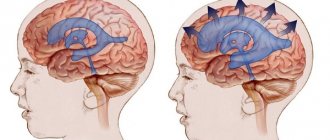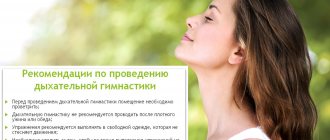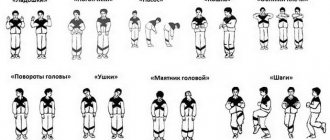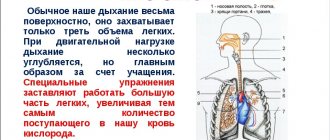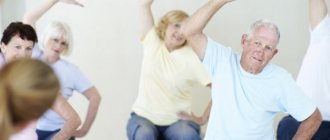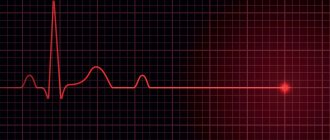The problem of high blood pressure worries many people. Hypertension develops for various reasons and significantly affects the quality of life.
There is an opinion that it is possible to normalize tonometer readings only through drug therapy. But the pills have a negative effect on the liver and kidneys.
Therefore, special breathing techniques have been developed to relieve the unpleasant symptoms of hypertension. The article will tell you what breathing exercises there are to lower blood pressure.
Tablets are ineffective in the fight against hypertension
If blood pressure rises frequently, a person usually consults a family doctor.
The doctor prescribes antihypertensive drugs. Medicines only relieve symptoms.
It is necessary to undergo a full examination for hypertension. But doctors are not always able to find out the real reason for the patient’s poor health.
A sharp increase in blood pressure is especially dangerous. In this case, tachycardia, tremors of the limbs, sweating, nausea, vomiting, headaches and dizziness are observed. Unfortunately, the effect of the tablets begins after an hour or two. Therefore, you have to call an ambulance to get an injection. This situation can be easily avoided if you know how to breathe correctly.
Special breathing practices (exercises) for hypertension help strengthen the condition of the vascular system and eliminate nervous tension, which is the main cause of increased blood pressure. Also, proper breathing helps normalize blood circulation and restore metabolism in the body.
But in severe cases of hypertension, you should not replace drug therapy with breathing exercises. This can lead to a number of negative consequences. It is better to combine both methods.
Basic rules of exercise therapy for hypotension
To make home workouts as effective as possible, you must meet certain criteria:
- It is recommended to perform the same exercises daily. The patient must comply with the number of approaches and rules for performing the exercise.
- To achieve visible results, you need to perform the exercises for at least 6 weeks. Only after this period the body begins to function differently, in a positive way for the patient.
- If you have not previously exercised, you should not immediately exhaust your body with too hard workouts. The load must be added gradually, the number of exercises performed should be increased every day, and the number of approaches should be gradually added.
Before you start performing a set of exercises, you need to visit a doctor for a consultation. This measure is necessary to exclude contraindications to exercise therapy.
Why does breathing practice help?
The state of health depends on how correctly biochemical processes occur in the human body. These processes are not affected by what foods a person eats or what drinks he drinks.
Thanks to special breathing, the body absorbs oxygen better. As a result, blood circulation is normalized and the load on the heart muscle is reduced.
Deep and even breathing has a positive effect on the functioning of the nervous system and quickly relieves tension, which often causes high blood pressure.
With a lack of breathing, tissue oxygen starvation occurs. In this case, a natural reaction of the body is observed - vascular tone increases, blood begins to be pumped with greater intensity. All this leads to a surge in pressure.
Specially designed breathing practices can reduce blood pressure and improve your emotional state.
What pressure is considered normal for the body?
In general, blood pressure in the vessels is one of the most important physiological parameters of the human body, on which both physical well-being and psychological balance depend, and based on them, ability to work, the ability to fully rest, and so on.
In many sources you can find that normal blood pressure is one at which its readings are 120 per 80 millimeters of mercury.
However, these indicators may vary for different ages and genders.
So, if we take an average, then for an adult the minimum acceptable indicators are 110 over 70 , and the maximum acceptable are 140 over 90 .
If they are higher, then it makes sense to talk about the initial stage of hypertension, and if they are lower, then about hypotension.
Now it becomes clear why it is so important to maintain blood pressure in order. Moreover, if its indicators strongly deviate from the norm, a deterioration in well-being is possible, including fainting and the inability to lead an active lifestyle.
And although traditionally, and quite deservedly, it is believed that high blood pressure is much more potentially dangerous to health and even life, low blood pressure should also not be neglected, because hypotension tends to progress and acquire stable forms.
What are the advantages?
The technique of breathing exercises was taken from pranayama - a teaching that is devoted to controlling the body with the help of breathing. Many people are skeptical about such exercises. But those who are tired of constant problems with blood pressure should still try gymnastics.
Breathing to reduce blood pressure is a truly effective method that has a number of advantages:
- You can do breathing exercises to lower blood pressure at any time and anywhere;
- no special conditions or devices are required;
- financial efficiency;
- health safety;
- fast action. In just a few minutes, the upper limit of pressure decreases by 25-30 units, the lower limit by 10-15;
- systematic implementation of practices allows you to extend your lifespan.
Hypertensive patients should not immediately abandon the breathing technique. It is recommended to try at least a few exercises. After all, they are simple and do not take much time.
Causes of changes in blood pressure
Let's look at the most common ones:
- Excessive abuse of bad habits;
- Poor nutrition and possible subsequent obesity;
- Common kidney diseases;
- Leading a passive lifestyle;
- Frequent stress and nervous tension.
Often, hypertensive patients think about the question, how long can they live due to their disease? In this case, the answer lies in the patient’s lifestyle and his attitude towards his body.
Subscribe to our INSTAGRAM account!
If you give up bad habits and bring your lifestyle back to normal, as well as regularly do breathing exercises for hypertension and perform other exercises, then you can live a long, happy life without regularly worrying about the disease.
If we consider medications separately, they can only temporarily relieve the symptoms of the disease, but the disease will return again and it is possible that with even greater force and threat to life.
Important! Regular use of medications for hypertension only delays the development of the disease; after stopping them, the disease returns again with even greater force, which is why many patients continue to take pills constantly, thereby destroying other vital organs.
How to reduce blood pressure by breathing?
Let's look at how to use breathing to reduce blood pressure at home in a short time.
To reduce blood pressure with breathing exercises, you must do the following:
- sit on a chair or armchair. Take an open position with your hands on your knees. The back should be straight, but not tense;
- relax by taking a few deep breaths and full exhalations. How you inhale and exhale air - through the mouth or nose - does not matter;
- take a full breath of air through your nose and exhale through your mouth. Repeat, releasing air through closed lips;
- do the same actions as in the previous stage, only add back and forth movements of the head: when taking in air through the nose, you need to slowly throw your head back, and when exhaling through your mouth, lower it to your chest.
All exercises must be performed without tension, measuredly. Sometimes you may feel dizzy. Then you need to pause for a minute and rest. When the condition returns to normal, resume practice. Those people who regularly use this technique claim that after three sessions the dizziness goes away, and a positive result comes much faster.
There are different breathing practices and exercises that are effective for hypertension. Often high blood pressure is accompanied by stabbing pain in the heart area. To eliminate this symptom, it is recommended to also perform mudras, as well as massage of acupuncture points located on the hands.
Breathing exercises from yoga
Yoga therapy includes breathing exercises that help against hypertension because they have the following effects:
- stabilize the removal of carbon dioxide, narrowing blood vessels and lowering blood pressure;
- activate the parasympathetic nervous system, the increased tone of which contributes to a lower tone of blood pressure, which is the key to lowering blood pressure.
Here are the exercises that hypertensive patients should learn:
- Tadagi mudra (diaphragm breathing). You need to lie on your back, bend your knees, extend your arms along your body and place your palms up. Relax your stomach, and then inhale deeply and slowly, protruding your stomach. Next, exhale, slowly lowering your stomach until the final phase, when it is slightly pulled under the ribs.
- Purna Shvasa Pranayama (full breathing). An effective technique that allows you to reduce pressure by 10-15 mm. The starting position is the same as in the previous exercise, that is, you need to lie on your back and bend your knees. Next, with an inhalation, you need to raise your hands up and behind your head. After exhaling, raise your arms again, but lower them along the body, that is, return to the starting position.
- Shashankasana (hare pose with diaphragm breathing). You need to sit on your heels, slightly spread your knees to the sides and exhale, lower your body down. Then rest your forehead on the floor, stretch your arms forward and relax your shoulders. With an inhalation, stick out your relaxed stomach, and with an exhalation, pull it in as far as possible towards the spine.
Qigong technique
The Qigong technique is the oldest method of healing. Gymnastics improves blood circulation by ensuring a constant exchange of carbon dioxide and oxygen. Qigong helps well with high tonometer readings.
The main thing is to follow a number of these rules:
- breathe with your diaphragm. The chest should be motionless;
- you should breathe through your nose;
- When you inhale, you need to stick your stomach forward, and when you exhale, you need to pull it in;
- keep your head straight;
- The spine and neck should form a straight line.
Qigong involves the use of different types of breathing:
- deep slow, when inhalation and exhalation have the same intensity;
- diaphragmatic rhythmic, in which the inhalation is slow and the exhalation is sharp.
Video: 3 breaths for hypertension
In the next video, Dr. Evdokimenko will tell you why it is better to treat hypertension not with medications, but with breathing exercises. It is enough to devote 10-15 minutes a day to it. The doctor will tell you in detail about the 3-breathing technique that helps against hypertension:
So, breathing exercises, especially when performed regularly and in combination with a diet, will not only normalize the condition of a hypertensive patient, but over time significantly reduce the intake of medications. To choose the right set of exercises and master their correct execution, it is worth consulting with a therapist.
Gymnastics Strelnikova
Breathing for hypertension according to Strelnikova shows good results. But for a sustainable decrease in tonometer readings, you need to be patient. It is better to exercise daily in the morning and before bed. As a result, after six months the pressure normalizes and stabilizes.
During Strelnikova’s gymnastics, it is important to follow a number of rules:
- perform all movements rhythmically, simultaneously with inhalation;
- take short and noisy breaths through your nose;
- When inhaling, close your lips, but do not squeeze them tightly;
- exhalation should be calm through the mouth;
- take eight breaths and exhales, and then rest for a few seconds;
- exercises are repeated 12 times;
- perform gymnastics while standing. But during the first practices it is better to sit. Because at the beginning of training sometimes dizziness occurs. This happens due to vascular disorders. There is no need to stop exercising: the dizziness goes away quickly.
There are different exercises by Strelnikova. The simplest and most effective are described below:
- "palms" . You need to stand up straight and bend your elbows. Raise your palms. Inhale briefly and noisily through your nose, while clenching your palms into a fist;
- "pump " Stand up straight and place your feet slightly wider than shoulder-width apart. Bend over a little. When bending over, you should take a noisy and active breath. As you exhale, rise up, but do not straighten up completely;
- "ears" . Tilt your head to the right, touching your ear to your shoulder and taking a sharp breath through your nose. Then tilt to the left;
- "epaulettes" . You need to stand up straight. Clench your palms into fists and press them to your stomach at waist level. As you inhale, sharply lower your fists down. At the same time, your arms should be tense and reach towards the floor. As you exhale, return to the starting position;
- "head turns " Turn your head to the right, taking a sharp breath. Perform a similar movement in the other direction. Exhalations are made spontaneously after each inhalation;
- "cat" . Stand straight, feet shoulder-width apart. Squat down sharply and turn your torso to the right. In this case, you should make a sharp sniff with your nose. Make a similar movement to the left;
- “Hug your shoulders . Raise your arms up to shoulder level. Bend your elbows and hug yourself, inhaling sharply through your nose.
A set of exercises according to Strelnikova
You can do all these exercises. But first, it’s better to do the first three. They will take approximately 10-20 minutes. If you repeat the practices twice a day, the entire gymnastics will take about half an hour. This is not much even for a very busy person.
It should be noted that performing the above exercises is also useful during a hypertensive crisis. The condition will quickly improve, and there will be no need to call an ambulance.
Breathing for lowering blood pressure using the Strelnikova system is quite effective. Many patients give positive feedback. But before using the technique, it is better to consult with your doctor.
Low blood pressure - what to do at home if you have a headache
One of the most common symptoms of low blood pressure is headache. At the same time, medications, in most cases, are quite effective.
What can be used (if there are no contraindications, read the instructions): Gutron, Ecdisten, Rantarin, Heptamil, Symptol and others.
Before using medications or folk remedies, be sure to consult your doctor.
From folk remedies - St. John's wort
One tablespoon of St. John's wort per glass of boiling water. Pour in the herb and leave for 55 minutes. Strain. Take a quarter glass daily before meals. Course: until the condition normalizes, no more than 8 days.
Recipe with lemon for headaches
Crushed lemon (about half a small fruit) should be poured with a glass of store-bought or homemade (not weaker than 40 degrees) vodka, infusing it in a glass container for 15 days. Drink 22 drops three times a day before meals. Course: until the condition normalizes, but no more than 10 days.
Recipe with ginseng
Take ginseng root, dry. Grind it, take one and a half teaspoons and pour 500 milliliters of store-bought or homemade (at least 40 degrees) vodka.
Leave for about two weeks. Take on an empty stomach, one teaspoon at a time, for one week. Next - another week, 2 teaspoons. Course: until blood pressure normalizes, but not longer than 15 days.
Tea or coffee
As already noted, these drinks can increase blood pressure. However, you should not abuse their quantity or strength.
1-2 cups of coffee with milk, or black or green tea per day will not cause harm, but will partially normalize the patient’s condition.
Products: short list
The following products and dishes made from them are recommended for inclusion in the diet for hypotensive patients:
- beans
- assorted nuts (fresh and dried)
- different types of meat
- potato dishes
- bitter dark natural chocolate
But there is a basic list of foods that increase blood pressure, you can include them in your daily diet.
Preventive measures to prevent situations from recurring
They consist in preventing the development of hypotension or its aggravation.
Among the tips that can be given if your blood pressure decreases or increases, buy yourself a tonometer. This way you will always know your blood pressure readings.
Prevention is the complete exclusion of provoking factors, that is, the causes of hypotension.
All of them have already been discussed above in this article. Eliminate them, and this will be the best preventive strike against hypotension.
Bubnovsky system
With high blood pressure, it is useful to perform the exercises recommended by Bubnovsky.
They are based on proper breathing and relaxation of the back. A person needs to get on all fours and arch his back. Next, sit on your right leg, while pulling your left leg back. Then pull your right leg forward as much as possible.
When moving, you should use your arms, putting them forward one by one. Exhalation is performed at the end points. Do 20 repetitions in one approach.
Then do a back stretch. Get into a position on all fours. Bend your arms at the elbows and lower your torso to the floor, while exhaling. As you inhale, straighten your arms, lowering onto your heels. This is repeated six times.
Breathing exercises according to Buteyko
Soviet scientist and physiologist Konstantin Buteyko believed that high blood pressure is a consequence of an imbalance of oxygen and carbon dioxide in the human body. So, he suggested the correct breathing technique, which helps eliminate such an imbalance.
10 exercises are performed on an empty stomach (the starting position is unchanged - sit on a chair, relax and look straight ahead):
- Inhale noisily for 5 seconds, then exhale for 5 seconds and relax for 5 seconds. Perform 10 such cycles.
- Inhale and exhale noisily for 7.5 seconds, but rest is still 5 seconds. Perform 10 cycles.
- Inhale through your nose, and when the maximum point of holding your breath is reached, do an acupressure massage of your nose and exhale slowly. 1st execution is enough.
- Close your right nostril with your finger and take 10 breaths in and out through your left nostril. Then close your left nostril so that you can take 10 breaths in and out with your right.
- While inhaling completely, pull your stomach in as much as possible and hold in this position for 7.5 seconds. Next, exhale as much as possible for 7.5 seconds and pause for 5 seconds. Perform 10 cycles.
- Take 12 inhalations and exhalations for 5 seconds each (preferably in 1 minute), and then immediately exhale as much as possible and hold your breath for as long as possible. 1st cycle is enough.
- The “slow breathing” exercise follows, which is performed in this order:
- for a minute, inhale-exhale-hold for 5 seconds (4 cycles);
- for 2 minutes, inhale-hold-exhale-hold for 5 seconds (6 cycles);
- for 3 minutes, inhale-hold-exhale-hold for 7.5 seconds (6 cycles);
- for 4 minutes, 10 seconds each, inhale-hold-exhale-hold (4 cycles).
- Exhale, hold as much as possible, inhale and also hold. 1st cycle is enough.
- Inhale and hold your breath as much as possible, repeat 3 to 10 times. Then do the same initially when walking in place, and then when squatting.
- The final exercise is to sit comfortably and relax, breathe through your chest, gradually reducing the volume of inhalation and exhalation so that your breathing becomes almost “invisible” and light, that is, at the level of the nasopharynx. Do the exercise for 3 to 10 minutes.
Conduct training in the morning and evening, but over time you can reduce their frequency by increasing the time by extending the time of breath holding and the number of exercise cycles.
Read also: Hypertensive crises in young people
Exercise sets
Breathing exercises to reduce blood pressure are performed in a complex of dynamic exercises (Strelnikova, Bubnovsky method), therefore, for different stages of the disease there are recommendations, depending on the severity of the hypertensive condition. If any discomfort occurs during execution, you should stop so as not to harm your health.
In the initial stages
In the first stages of the development of hypertension, doctors recommend paying attention to the Bubnovsky complex, which includes “diaphragmatic” breathing. It is performed in a supine position. When you inhale, the stomach protrudes upward as much as possible, the entire chest cavity is filled with air, and when you exhale, it is drawn in deeply and tends to press against the spine. The number of inhalations and exhalations in one cycle is 5-7, the number of approaches is 3-5.
In hypertensive crisis
In severe stages of the disease, for example in hypertensive crisis, dynamic exercises are not worth doing. Gentle gymnastics is recommended, for example a number of exercises from the Strelnikova method. Reduce the number of approaches and the time of sharp breathing between them. Do everything while sitting, very carefully, calmly, carefully observing your condition.
For headaches
Strelnikova’s methods are excellent for relieving headaches. During an attack, before each exercise, take 3-4 short noisy exhalations, then rest for 10 seconds, repeat the cycle three to five times. In a sitting position, do the basic exercises for hypertensive patients - “Palms”, “Shoulder straps” and “Pump”, then get up and complete the entire complex, excluding “Pendulums”, “Head turns”, “Ears”.
To improve your well-being
To improve your well-being, breathing exercises for hypertension should be performed regularly, preferably every day. Before starting Bubnovsky classes, it is necessary to warm up the body, as before physical therapy. Each of the described complexes has its own advantages and disadvantages, is effective in its own way, and requires an individual approach. Try working out using different methods to see which one suits you best.
A little about hypertension
Hypertension manifests itself in persistent high blood pressure. As a rule, the indicators constantly exceed the norm. Often you can see a figure of 140/90 mmHg on a tonometer. Perhaps this is the most common disease of the cardiovascular system.
The appearance of an illness does not occur without a reason. Certain factors contribute to its development.
- Excess weight. This applies to people who do not follow their diet, lead a sedentary lifestyle, have an impaired metabolism and are prone to obesity.
- Stress and emotional overstrain. This factor also includes fears, worries, overwork, and depression. In stressful situations, a person produces adrenaline, which leads to increased blood pressure.
- Heredity. If your relatives of older generations have had cases of a similar disease, then the risk of developing the pathology increases significantly due to predisposition. Primary symptoms appear at a young age.
- Lifestyle. As a result, smokers and people who abuse alcohol develop hypertension. The reason for this is the negative impact of toxic components on the cardiovascular system.
- Brain injuries. This could be either bruises received in an accident or hypothermia in the cold.
- Viral and infectious diseases. There are a number of diseases (sinusitis, meningitis, frontal sinusitis) that negatively affect the cardiovascular system.
Read also: Thesis on hypertension
In addition, age-related changes in blood vessels lead to the development of hypertension. The risk group includes women whose age has “overstepped” 40 years - this is due to the onset of menopause. The chances of hypertension also increase in people who spend long periods of time at the computer. Cholesterol plaques interfere with normal blood circulation. High cholesterol levels are another cause of high blood pressure.
The main symptom of the disease is headache. There is also tinnitus, decreased vision, “flying spots” in front of the eyes, patients are overcome by insomnia, the head becomes heavy, the heartbeat increases significantly and all symptoms are accompanied by general weakness. Such a description is the development of the disease at an early stage.
At later stages, the development of heart failure is noted. Due to increased pressure, the heart muscle is susceptible to overwork. Moreover, many patients complain of nosebleeds, nausea, poor memory, increased eye pressure and swelling.
Important! When the first signs appear, you should immediately contact a specialist to avoid complications.
